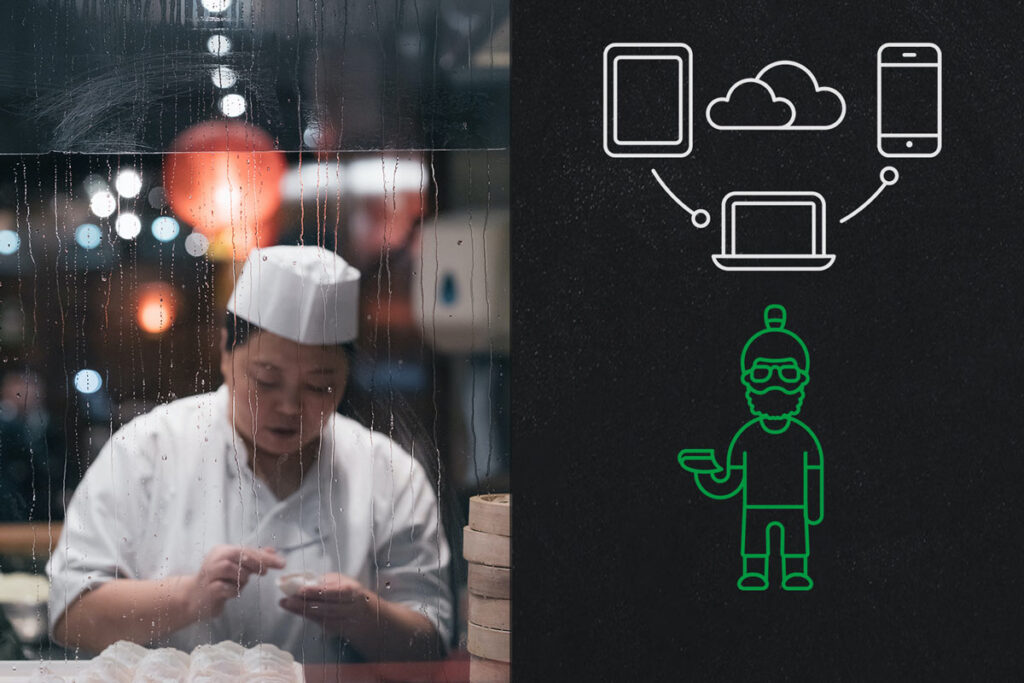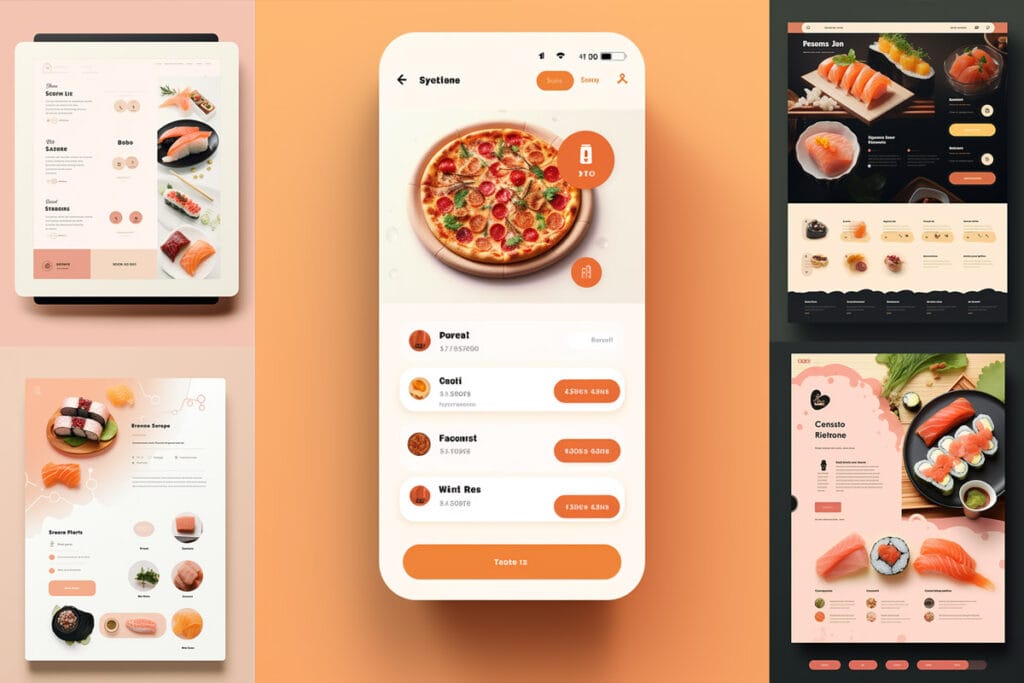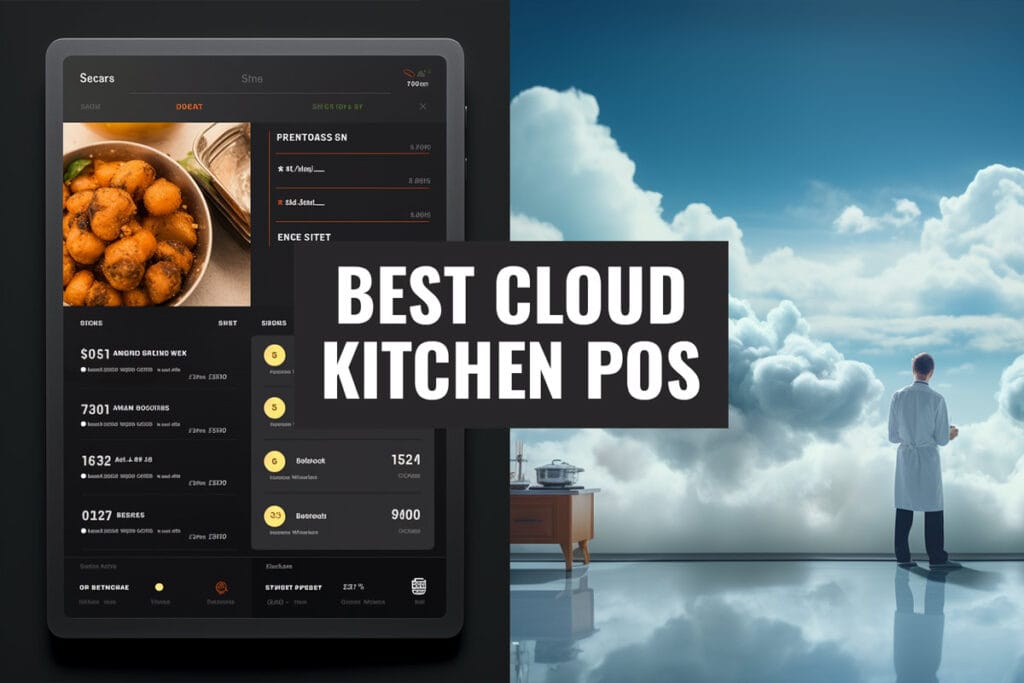Hungry for a slice of the ghost kitchen trend? This is your guide to the virtual restaurant model shaking up the food industry.
Ghost kitchens are delivery-only culinary facilities optimized to meet the on-demand dining habits of today’s foodies. No storefront. No seating. Just meals made for takeout and app orders.
As third-party delivery explodes, these crafty kitchens let restaurants expand without the crushing overhead of traditional retail spaces. Lower cost. Higher margins. Scalability on-demand. An entrepreneur’s dream, right?
Well…not so fast. Opening a ghost kitchen isn’t as simple as firing up the fryers. The right location, concept, and marketing mix are key to survival.
Let’s find out if the future of food is emerging from the kitchen.

What Exactly is a Ghost Kitchen?
A ghost kitchen, sometimes referred to as a virtual restaurant, cloud kitchen, or dark kitchen, is a professional food preparation facility that exclusively fulfills online delivery and takeout orders.
Ghost kitchens do not offer any dine-in seating or services. They operate out of low-cost commercial kitchen spaces designed specifically for food production, without investing in an attractive retail storefront location or front-of-house furnishings and decor.
No Physical Location for Customers
The “ghost” in the name comes from the fact that these delivery-only establishments don’t technically exist in a tangible, visible location that customers can physically visit. They simply operate behind the scenes, only fulfilling orders placed through third-party food delivery apps and services.
The global market size of ghost kitchens was valued at over $56 billion in 2021 and is expected to continue growing rapidly, with over 100,000 ghost kitchens now operating worldwide [Source].
Optimized for Delivery Efficiency
Without the costs associated with serving in-house patrons, ghost kitchens can focus on food preparation and maximizing delivery efficiency. They rely entirely on partnerships with major delivery providers like UberEats, DoorDash, Grubhub, and Postmates for order volume and sales.
Meeting Surging Delivery Demand
The ghost kitchen model has emerged to take advantage of the rapidly rising consumer demand for food delivery. For existing restaurants or entrepreneurial chefs, they provide a means to grow a delivery business without the startup costs and overhead of a full-service dine-in establishment.
Virtual Restaurants with No Dining Room
Ghost kitchens are delivery-only operations, optimized exclusively for preparing dishes intended to travel well and satisfy customers ordering food digitally. Since they have no brick-and-mortar restaurant or seating, aesthetics, and plating are less of a priority compared to food quality. The dining ambiance is irrelevant without a dining room.
Lower Overhead than Traditional Restaurants
The lack of a storefront and wait staff to pay allows virtual kitchens to operate with fewer staff and lower overhead. And because they don’t rely on in-person foot traffic or visibility for sales, ghost kitchens can be located anywhere with affordable rent that offers convenient access to neighborhoods with high delivery demand.
Disruptive New Restaurant Model
The rise of ghost kitchens has become one of the most intriguing and potentially disruptive restaurant industry innovations in recent years. Their growth has accelerated rapidly to meet expanding consumer demand for delivery. For owners, they represent an appealing new path to entering the increasingly competitive foodservice market.

Types of Ghost Kitchen Models
There are several different types of ghost kitchen business models that restaurateurs can choose from:
Independent Ghost Kitchens
An independent ghost kitchen is built from the ground up specifically for delivery-only food preparation. Everything from the kitchen layout to cooking equipment is designed exclusively for efficiently fulfilling online orders. They operate as standalone delivery facilities without an associated dine-in restaurant.
Independent ghost kitchens require upfront capital investment to build out the kitchen space but allow full control over branding, menus, and operations. Owners can find affordable leased commercial spaces in areas with high demand for delivery.
Existing Restaurant Virtual Brands
Some dine-in restaurants are leveraging their existing kitchens to offer virtual restaurant concepts for delivery in addition to their core in-house menu. This allows testing new menus and maximizing kitchen utilization during slack periods.
The main restaurant handles dining patrons while their kitchen doubles as a ghost kitchen during off-peak hours to serve delivery orders under different virtual brand names. Minimal added costs to try new concepts.
Shared Ghost Kitchens
Shared ghost kitchens allow multiple restaurant brands to operate delivery-only menus side-by-side in the same kitchen facility. Owners split commissary-style kitchen rental costs and share equipment expenses.
Allows smaller restaurants to gain access to a licensed commercial kitchen without each fully footing the bill. Provides an affordable way to enter the ghost kitchen market for testing.
Leased Kitchen Pods
Some ghost kitchen providers like CloudKitchens offer modular kitchen spaces that restaurants can lease on a flexible short-term basis to test delivery-only concepts.
CloudKitchens provides all the major equipment so restaurants can get up and running quickly. Ideal for experimenting with menu concepts before committing to permanent space.
The diverse ghost kitchen models provide restaurant owners with multiple pathways to leverage this innovative concept using options that best align with their resources and goals.
Here are some factors to consider when choosing between ghost kitchen models:
- Startup costs – Independent ghost kitchens require more upfront investment in building out a kitchen vs. utilizing an existing restaurant kitchen or leasing a modular pod.
- Flexibility – Using an existing kitchen for virtual brands allows testing concepts without major costs. Leased pods also provide short-term flexibility. Independent build-outs are longer commitments.
- Control – With independent kitchens, you maintain complete control over branding, menus, equipment, etc. Shared or leased models mean collaborating with other users.
- Staffing – Independent kitchens require a full staff. Leveraging existing kitchens allows for efficiently utilizing the same staff across dine-in and ghost brands.
- Menu options – Independent kitchens allow specialized equipment and layouts tailored to cuisine. Shared kitchens limit equipment and storage capabilities per restaurant.
- Order volume – Independent kitchens have a higher capacity to scale order volume. Shared spaces may have peaks where orders exceed kitchen capacity.
- Locations – Independent kitchen placement is fully flexible based on real estate. Leased pods limit options to where the provider offers space.
- Regulations – Some regions limit shared kitchens. Independent build-outs avoid regulatory issues around sharing commercial facilities.
Weighing factors like cost, control, and scalability will determine the best ghost kitchen approach for a restaurant’s specific goals and market conditions. Testing concepts in shared or leased ghost kitchens before eventually expanding into a dedicated independent location is also a viable strategy.

The Rise of Ghost Kitchens
Fueled by Delivery Apps
The emergence and growth of ghost kitchens have been fueled by the explosive popularity of third-party online food delivery apps and services. Companies like UberEats, DoorDash, GrubHub, Postmates, and other delivery drivers have changed consumer dining habits and enabled demand for convenient delivery.
Off-Premise Capacity Challenge
As more customers shifted to ordering food digitally, traditional dine-in restaurants struggled with off-premise orders crowding capacity in kitchens designed for in-house dining. Ghost kitchens emerged as an appealing solution by offering delivery-only facilities optimized for digital orders.
Lower-Cost Model
For many restaurateurs seeking expansion, opening additional retail locations with spacious dining rooms didn’t make sense for primarily fulfilling takeout and delivery orders. The high rents and build-out costs of traditional restaurant real estate far exceeded the required investment for a kitchen catered to online ordering.
Optimized for Delivery
Ghost kitchens allow owners to tap into the surging market for food delivery without the financial burdens of opening more full-service establishments. By eliminating dining rooms and focusing exclusively on kitchen operations, overhead costs are far lower.
Testing New Concepts
These virtual restaurants also provide an ideal canvas for testing out new concepts and menus specifically tailored to match consumer ordering patterns. Owners can experiment with creative offerings like meal kits, bowls, and trendy dishes outside their core dine-in brand.
Aligned with Digital Trends
The ability to innovatively expand reach and menus beyond the physical and operational constraints of a traditional restaurant has driven adoption. Ghost kitchens solve critical needs amplified by the rise of the digital dining experience. Their popularity will likely continue growing in parallel with delivery demand.
Benefits for Owners and Consumers
For owners, the benefits are clear – maximize revenue opportunities from delivery and takeout without expensive retail build-outs. For consumers, it means more dining options and shorter wait times for food. The rise of ghost kitchens is reshaping the industry.
You might also like: Best Cloud & Ghost Kitchen POS Systems

Ghost Kitchen Benefits for Restaurateurs
Operating a ghost kitchen provides several advantages compared to a traditional dine-in restaurant model.
Lower Startup Costs
Opening a retail restaurant location requires investing in dining room furnishings, attractive storefronts, sensory elements like music and lighting to create ambiance, plus added space for seating, bars, etc.
Ghost kitchens avoid those front-of-house costs by eliminating dining space and focusing just on an efficient cooking area. The cost to build out a basic kitchen is substantially lower than a full-service restaurant.
You might also like: How to Start a Ghost Kitchen Business: A Step-by-Step Guide
Wider Location Options
Choosing real estate for a dine-in restaurant depends heavily on factors like visibility, foot traffic, parking, and aesthetics to attract walk-in business. This significantly narrows options and raises the rent.
Ghost kitchens simply need affordable spaces conducive to food production. Proximity to higher-density areas for delivery demand matters most. More commercial and industrial locations become viable.
Less Staffing Required
Ghost kitchens have no need for traditional front-of-house staff like servers, hosts, bartenders, and bussers. This allows concentrating roles in a smaller kitchen team of cooks, prep, washers, and drivers.
Labor costs are optimized by only needing staff essential to food preparation and fulfillment. Additionally, specialized training around hospitality and service standards is less extensive without dining room service.
Scalability and Flexibility
Expanding dine-in capacity requires securing additional real estate and investing in further space build-outs. Ghost kitchens can readily add incremental equipment and staff to raise output from the same leased space.
Going from 25 to 50 orders per hour may just require some added prep tables or cook stations in an existing ghost kitchen. Rapid scalability provides flexibility to meet demand spikes.
Testing New Concepts
For existing restaurants, opening a ghost kitchen under a different brand name allows safely experimenting with new menus explicitly tailored to delivery and takeout.
Different cuisine styles can be tested without impacting or diluting the dining experience at their core restaurant location.
Lower Ongoing Overheads
In addition to lower startup costs, ghost kitchens enjoy savings on monthly overheads compared to traditional restaurants. Rent is cheaper without needing a premium retail site. Staffing costs are minimized with a delivery-focused team.
Utility costs may also be lower without front-of-house lighting needs, and liability insurance rates can be more affordable with no dine-in patrons. These compound into significant ongoing savings.
Focus on Food Quality
With off-premise dining, the taste, texture, and integrity of food itself are disproportionately important compared to ambiance. Ghost kitchens allow an obsessive focus on execution quality.
Cuisine can be crafted specifically for travel and reheating using specialized packaging. Menus are designed around core dishes known to satisfy rather than the overall dining experience.
Delivery Streamlined
Building workflows tailored for delivery provides optimization benefits. Handoff points minimize driver wait times. Bagging, labeling, and packaging stations support efficiency. Routing maps cut delivery windows.
For owners excelling at operations but lacking hospitality savvy, eliminating dine-in service allows playing to their strengths while satisfying off-premise demand.
Improved Order Technology
Ghost kitchens can fully integrate order management platforms and tablets that seamlessly flow orders from consumers to production.
Point-of-sale and front-of-house systems are not necessarily required, but we still recommend a good ghost kitchen POS system for not only coordinating all your orders from various platforms into a single interface, but also to track ingredients, manage staff, marketing loyalty and access to valuable data analytics.
Delivery-only technology stack removes pain points that disrupt the flow. Owners gain insights into key metrics like order frequency, delivery times, and menu item popularity.
The advantages of the ghost kitchen model are driving adoption. When executed successfully, they can be an extremely appealing vehicle for expansion, experimentation, and profitability.
Potential Challenges of the Ghost Kitchen Concept
While ghost kitchens provide advantages, owners should also be aware of some potential downsides to factor into planning:
Reliance on Third-Party Delivery
Unlike a dine-in restaurant that can market directly to walk-in guests, ghost kitchens depend heavily on delivery apps and services for orders. This means:
- Commission fees of 25-30% per order going to the third party
- Potential service interruptions if delivery apps have outages
- Changes to algorithms that impact search placement and visibility
- Ratings and reviews on external platforms outside the restaurant’s control
This heavy reliance on delivery partners creates vulnerability. Margin erosion from commissions is also a common pain point.
Less Control Over Branding and Marketing
Without a physical location and direct guest interactions, most branding and marketing happen digitally through delivery apps or social platforms. This makes it harder to control messaging and guest perceptions.
Nuances like food styling, photography, descriptions, and guest service fall more into the hands of third parties. Reinforcing identity through decor and atmosphere isn’t possible without a storefront.
Operational Complexities
Maintaining quality and execution with off-premise delivery adds layers of complexity compared to plating meals for immediate consumption:
- Packaging that preserves temperature, integrity, and presentation
- Coordinating courier pickup and optimizing delivery routes
- Timing preparation so food finishes precisely when drivers arrive
- Avoiding delivery delays that erode quality or cause bad reviews
Menu Limitations
Some restaurant concepts don’t translate well to delivery-only. Intricate plating and presentation are lost. Hot foods can cool and textures soften during transit. Expectations around customized orders may not be met.
Certain family-style or fine-dining experiences can’t be properly replicated for takeout. Menus must focus on dishes known to satisfy after travel.
Impersonal Character
For diners, part of the appeal of dining out is the sensory environment and hospitality. Without a storefront, ghost kitchens have less ability to create a distinctive space reflecting the chef’s personality or themes.
The challenge is creating brand affinity and an emotional connection solely through food and digital touchpoints. This is critical for building customer loyalty.
While the advantages are evident, ghost kitchen operators should anticipate addressing these potential disadvantages with careful planning, testing, and execution.

Ghost Kitchens – Where Delivery is Going
It’s clear the popularity of ghost kitchens has rapidly accelerated, but is this a passing fad or an enduring shift? There are several signs indicating the growth of ghost kitchens is here to stay:
Post-Pandemic Off-Premise Shift
The pandemic necessitated a sharp pivot toward off-premise dining. This introduced many new customers to delivery who will likely continue ordering takeout and delivery from a delivery-only restaurant.
Ghost kitchens emerged to help meet the spike in delivery demand. Their optimized operations are aligned with post-pandemic dining habits.
Younger Generations Embrace Delivery
Younger demographics like millennials and Gen Z are especially accustomed to the convenience of food delivery service. Having grown up with smartphones, ordering meals to their doorstep is second nature.
A recent study carried out in the United States revealed that 69% of Generation Z individuals mentioned having used a third-party food aggregator within the last six months (Source).
As younger generations drive more sales, restaurants must cater to their preferences for seamless digital experiences and delivery-friendly menu options.
Revenue Diversification
Adding delivery and takeout revenue has become critical for restaurants as digital ordering displaces some in-house dining occasions. Investing in specialized off-premise capabilities like ghost kitchens provides an important revenue diversification strategy.
Rather than limiting growth to physical locations, ghost kitchens allow scaling a proven menu digitally to more customers.
Optimizing for Digital
Consumers are increasingly discovering and ordering from restaurants through digital channels. Visibility and convenience on delivery apps have become vital.
Purpose-built ghost kitchens designed around online ordering and partner apps provide optimized operations to thrive in the digital-native marketplace.
While some concepts like intimate fine dining will retain the classic dine-in format, ghost kitchens now offer a compelling low-cost model for expansion that is here to stay. Restaurants must be equipped to serve their customers whenever and wherever demand originates.
Key Takeaways on Ghost Kitchens
Ghost kitchens represent a transformative shift in the restaurant industry. Here are some key takeaways from their unique model:
- Ghost kitchens operate out of low-cost commercial kitchens without dining rooms for in-person service. They fulfill delivery-only orders placed through apps.
- For restaurateurs, they provide faster, lower-cost setups than traditional retail restaurants. The model optimizes operations for off-premise dining.
- Benefits include lower overheads, smaller staffing needs, more location flexibility, and the ability to experiment with new menus.
- However, ghost kitchens rely heavily on delivery apps for orders. Branding and marketing control are lower without a storefront presence.
- When considering a ghost kitchen, factor market demand, cuisine type, staff capabilities, branding needs, and growth goals into decision-making.
- Adding a ghost kitchen alongside existing dine-in locations can be an effective hybrid approach for many established restaurants.
- For new owners, starting with a small ghost kitchen has a lower barrier to testing concepts before expanding into full-service locations.
- Although not right for every restaurant, ghost kitchens are aligned with consumer delivery preferences and are an important model restaurateurs should understand.
This overview covers the key opportunities and considerations around operating a ghost kitchen. As customer habits evolve, ghost kitchens provide a model poised for long-term growth and profitability.
Read more: How to Write a Ghost Kitchen Business Plan (With Examples)
What are The Differences Between a Ghost/Cloud/Dark Kitchen and Virtual Restaurant?
There are some subtle differences between the terms ghost kitchen, cloud kitchen, dark kitchen, and virtual restaurant:
- Ghost kitchen refers to a commercial kitchen facility focused solely on food preparation for delivery. They have no dine-in space and customers order through apps or websites.
- Cloud kitchen is another common name for a ghost kitchen, drawing a comparison to cloud computing and the virtual, online-only nature of these delivery restaurants.
- Dark kitchen is similar to ghost kitchen, referring to their lack of a retail storefront. The “dark” implies they operate behind the scenes.
- Virtual restaurant refers to a food business that exists entirely online without a physical location. Some use virtual restaurant and ghost kitchen interchangeably.
- However, a key difference is that a virtual restaurant can be a brand that doesn’t operate its own kitchen, but sells food prepared in an existing ghost kitchen.
- So a ghost kitchen is the actual facility while a virtual restaurant is a digital brand, but often they overlap.
In summary:
- Ghost kitchen and cloud kitchen refer to the physical commercial cooking facilities focused on delivery.
- Dark kitchen is another term for the same concept.
- Virtual restaurant is more about the online brand identity rather than the physical space.
Examples of Successful Ghost and Cloud Kitchen Businesses
- Kitchen United – A ghost kitchen operator that provides modular kitchen spaces for restaurants to lease on-demand in areas with high delivery demand. They have dozens of locations across the US.
- CloudKitchens – Founded by former Uber CEO Travis Kalanick, CloudKitchens is one of the largest ghost kitchen operators with real estate and logistic support for virtual brands.
- Nextbite – A virtual restaurant group created by foodservice distributor US Foods which provides fully turnkey delivery-only menus and branding for operators to use.
- Reef Technology – Their Kitchen Operations Support service is aimed at providing comprehensive solutions for businesses in the food industry. They offer a unique model that combines innovative technology with strategically located facilities to create delivery-only kitchens.
- Tender Shack – Spun off from Danny Meyer’s Shake Shack brand, this chicken sandwich virtual restaurant operates from Shake Shack and other kitchens.



